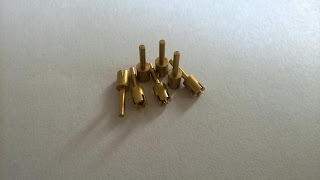Options for micro-holemaking
As
in the macroscale-machining world, holemaking is one of the most— if not the
most—frequently performed operations for micromachining. Cnc machining Many options exist for
how those holes are created. Each has its advantages and limitations, depending
on the required hole diameter and depth, workpiece material and equipment
requirements. This article covers holemaking with through-coolant drills and
those without coolant holes, plunge milling, microdrilling using sinker EDMs
and laser drilling.
Helpful Holes
Getting coolant to the drill tip while the tool is cutting helps reduce
the amount of heat at the tool/workpiece interface and evacuate chips
regardless of hole diameter. Cnc machining But through-coolant capability is especially
helpful when deep-hole microdrilling because the tools are delicate and prone
to failure when experiencing recutting of chips, chip packing and too much
exposure to carbide’s worst enemy—heat.
When
applying flood coolant, the drill itself blocks access to the cutting action.
“Somewhere about 3 to 5 diameters deep, the coolant has trouble getting down to
the tip,” said Jeff Davis, vice president of engineering for Harvey Tool Co.,
Rowley, Mass. “It becomes wise to use
a coolant-fed drill at that point.”
In
addition, flood coolant can cause more harm than good when microholemaking.
“The pressure from the flood coolant can sometimes snap fragile drills as they
enter the part,” Davis said.
The
toolmaker offers a line of through-coolant drills with diameters from 0.039"
to 0.125" that are able to produce holes up to 12 diameters deep, as well
as microdrills without coolant holes from 0.002" to 0.020".
Having through-coolant capacity isn’t enough, though. Coolant needs to
flow at a rate that enables it to clear the chips out of the hole. Davis
recommends, at a minimum, 600 to 800 psi of coolant pressure. “It works much
better if you have higher pressure than that,” he added.
To
prevent those tiny coolant holes from becoming clogged with debris, Davis also
recommends a 5μm or finer coolant filter.
Another recommendation is to machine a pilot,
or guide, hole to prevent the tool from wandering on top of the workpiece and
aid in producing a straight hole. When applying a pilot drill, it’s important
to select one with an included angle on its point that’s equal to or larger
than the included angle on the through-coolant drill that follows. The pilot
drill’s diameter should also be slightly larger.Cnc machining For example, if the pilot
drill has a 120° included angle and a smaller diameter than a through-coolant
drill with a 140° included angle, “then you’re catching the coolant-fed drill’s
corners and knocking those corners off,” Davis said, which damages the
drill.
Although not mandatory, pecking is a good
practice when microdrilling deep holes. Davis suggests a pecking cycle that is
30 to 50 percent of the diameter per peck depth, depending on the workpiece
material. This clears the chips, preventing them from packing in the flute
valleys.

没有评论:
发表评论